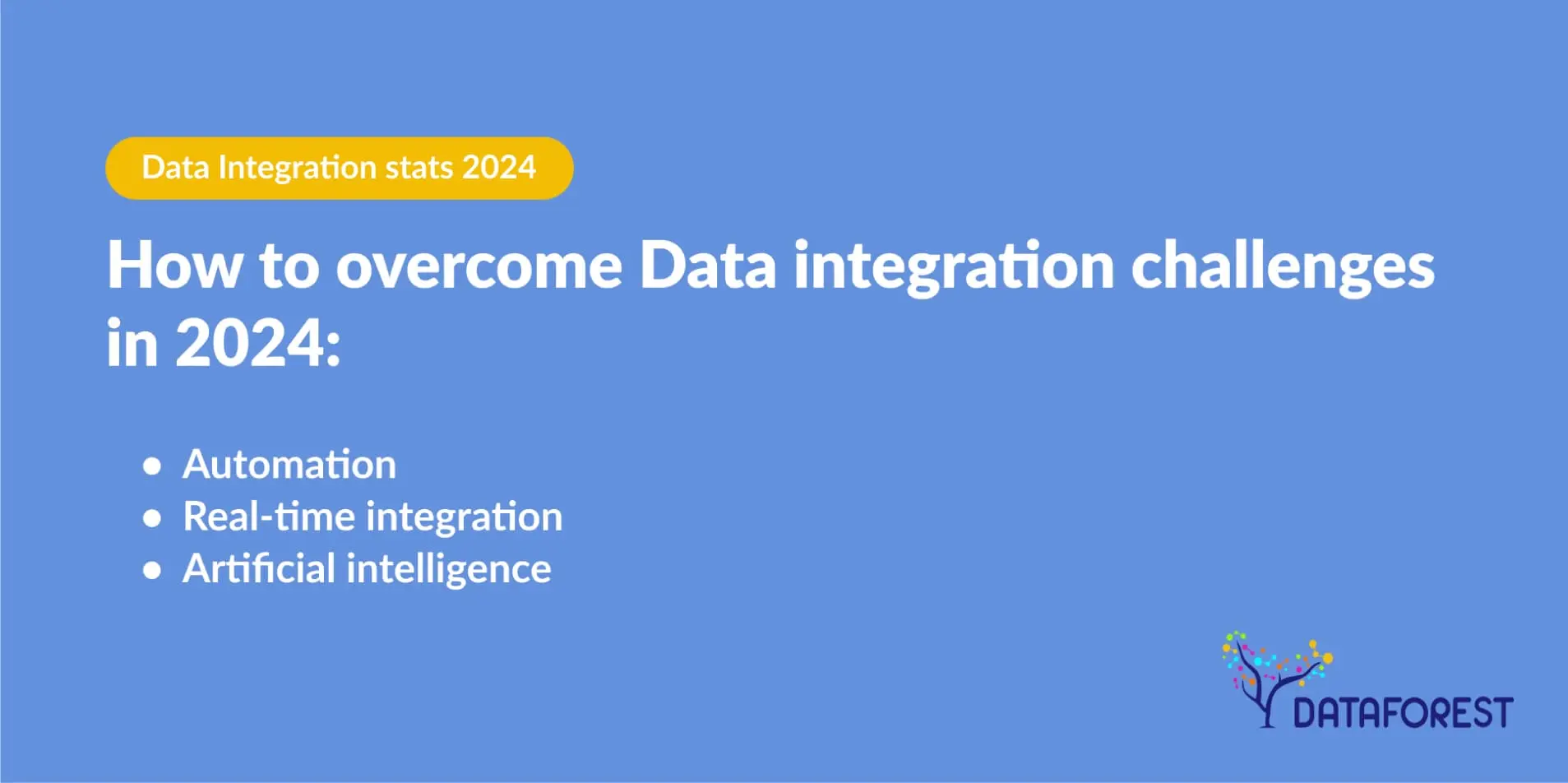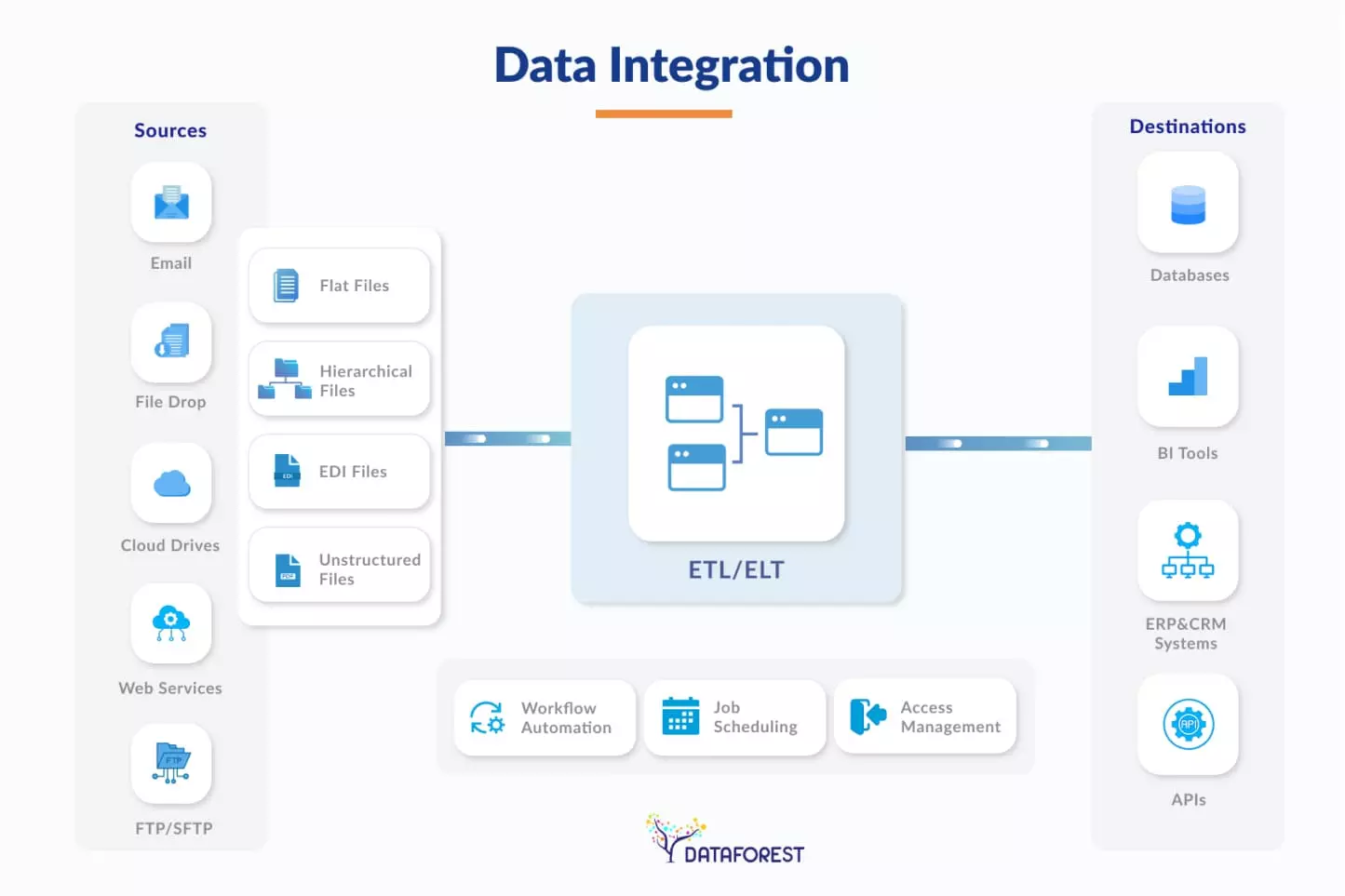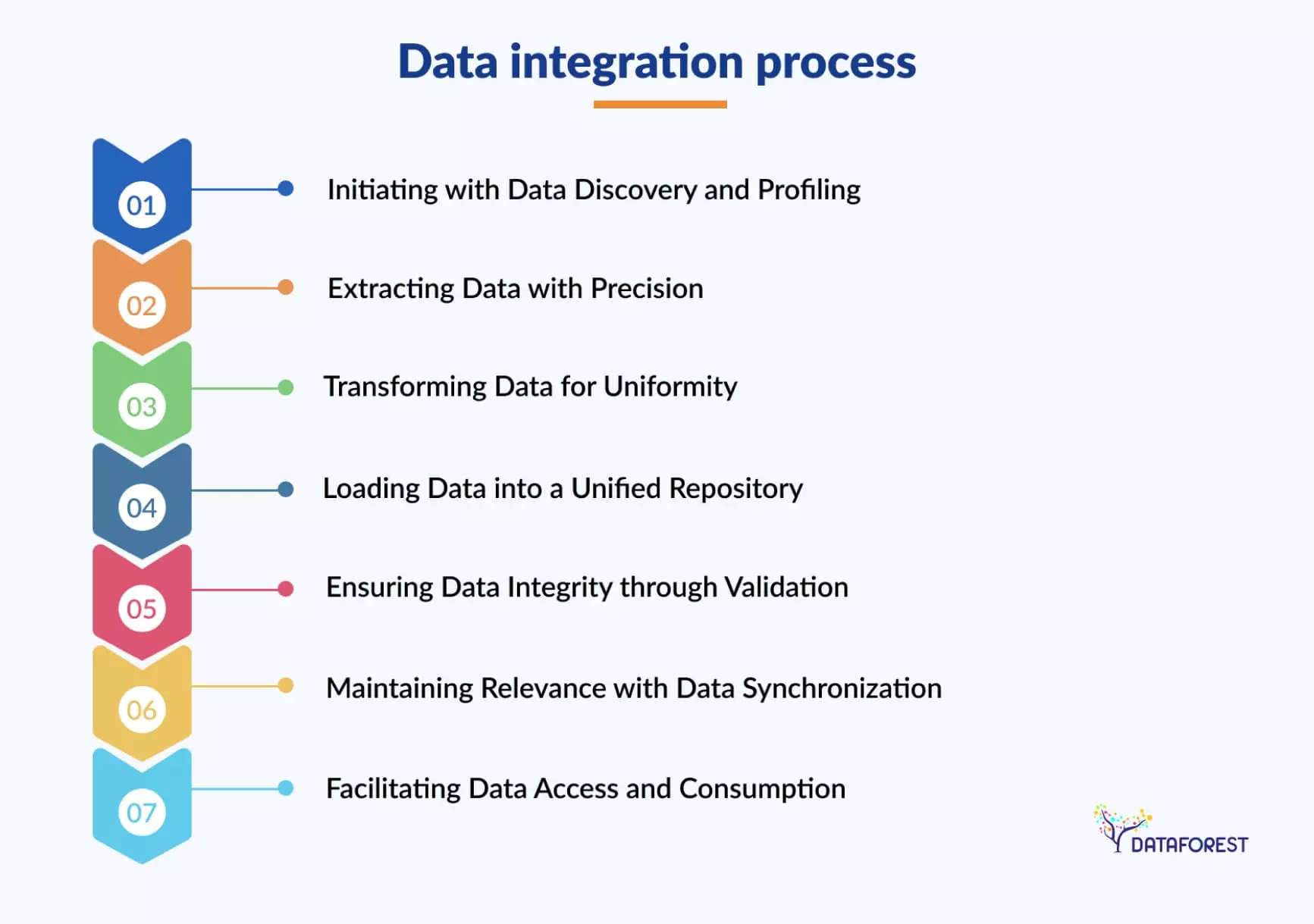The capacity to combine data is a significant success factor in the modern data-based world as well. This is not a mere process of integrating different streams of data into an integrated cohesive unit which will allow organizations to make sound decisions, business efficiency and strategic superiority. The need to integrate information with expertise is further enhanced by the bulk and complexity of information and hence the reason why it is a mandatory component of the infrastructure in the digital business environment. Make a call when you are ready to be on the frontline of the technology at any time.

The market of data integration is not yet in the relevant development and evolution by 2024. It is projected that the world market will be USD 13.60 billion (further increasing at a CAGR of 11.9 percent) between 2024 and 2032, as it will attain USD 37.39 billion by 2032.
A survey of more than 600 Chief Data Officers (CDOs) substantiates some arguments as far as the practice and strategies of data integration are concerned. Trusted data is the most significant focus in 2024 as one of the building blocks to providing trusted AI. Data has to be handled with critical concern, ethics, and reason to ensure that the organization will benefit from the generative AI. The other significant aspect that the CDOs have put forward is the necessity to create data management solutions that would enable the use of AI. Several organizations are also engaged in improving the quality and privacy of data, integrating, and developing an engineering level of data in a bid to gain greater control of the overall data management and running. These are necessary to the priorities of the operator data strategy and the application of the fullest generative AI technologies.
The process of data integration, in its nature, is the strategic amalgamation of the information from various sources that is transformed and adjusted to form one available repository. It is not merely a data merging process, but it coordinates format alignment, corrects differences, and enhances data quality. Companies disclose simplified, credible data base, which is amicable to strategic analysis and intelligence through the intricate data integration processes.
Deciphering the Data Integration Process
What is the Data Integration Process?
The nature of the data integration process merely means a precise combination of several groups of data into one. This conflux means the recalling of information in the greatest number of resources, its standardisation, and its ultimate summation. It is not just the mere aggregation or the conglomeration of the data features to the effect of converging and making it implementable. It is a comprehensive process, which includes data cleansing, transformation, and enrichment elements and concludes with a single, trustworthy data ecosystem. Select what you need and call.

Advantages of a Proficient Data Integration Process
Embarking on a proficient data integration project plan yields substantial rewards:
- Strategic Decision-Making: The use of a single data panorama provides all the information to the organization, and it generates data-driven, nuanced actions.
- Streamlining of operations: When there are no duplicate sources of data and the allocation of resources is optimized, then efficiencies are many-fold.
- Quality Data at the Forefront: As a part of the data integration process, there comes the data refinement, which is an assurance that the data shall be accurate, consistent, and trustworthy.
- Better Customer Understanding: Integrated data will help the business to develop a deeper understanding of the customer dynamics, which will enhance their engagement and satisfaction.
- Flexibility and Expandability: An appropriately designed pipeline data integration is the basis of scalability since it can make use of new sources of data and adapt to the shifting business needs with agility.
- Compliance and Governance: A unified data warehouse assists in fulfilling the regulatory demands, which amplify the data-governance models.
It is not only a technical task that has to be undertaken in a strategic manner, but it is also a requirement in the business. It assists organizations in defying the complexity of the modern data environments with the touch of a hat, transforming the raw data into a strategic asset.
Data Integration Steps
In making data-inspired choices, the skill to master the procedure of information combination is important to entities that need to extract the full range of insights and the value of non-related information sources. It is a complicated procedure that is followed by several well-coordinated steps to incorporate, refine, and bring data from any sources to the strategic analysis. It is under such critical points of the data integration process that we will explore the critical process steps of data integration, providing a road map of how a successful data integration process can be carried out to increase the utility of data and the business intelligence.

1. Initiating with Data Discovery and Profiling
The first step in the process of data integration is data discovery and profiling, which is an initial stage of the journey, the same way an expedition is charted before a journey is undertaken. The phase involves immersion into the world of data, the recognition of the endless streams that contribute to the informational ecosystem of the organization. In this case, it is the specifics of each data source, its structure, quality, and peculiarities that one should grasp to prepare the ground on which the integration will be seamless.
Take the example of a financial institution that includes the information relating to various customer contact points. The discovery stage would involve mapping data on the online banking systems, customer service interactions, and transactional systems, evaluating them in terms of format consistency, integrity, and completeness.
2. Extracting Data with Precision
After being discovered, the data integration process proceeds to data extraction. It is a very crucial step that involves data extraction of its original repositories, and this may be difficult without precision and sensitivity because it may interfere with the functionality of the source systems. The difficulty is to marshal information efficiently in its silos, so that it is ready for the next stage transformation step.
Take a case of a multinational corporation that is consolidating operations data in its subsidiaries located all over the world. The extraction consists of the retrieval of the data from different ERP systems, each having its own schema and data standard, to prepare it to be used in a company analysis.
3. Transforming Data for Uniformity
The transformation of data is the core of the data integration process. The different data elements are standardized, purged, and harmonized at this step to make them talk in a common language. This is a key change because it shifts a silhouette of heterogeneous data into an integrated dataset that is already coherent.
A good case in point may be an online shop incorporating customer engagement information on various platforms. In this case, social media interaction, web visit, and purchase history data are normalized and deduplicated, and thus can be analyzed as a coherent dataset.
4. Loading Data into a Unified Repository
After the transformation process, the next stage of the data integration process is the process of loading data. This stage includes the movement of the refined information into a central repository, which is a data warehouse, and stored, accessed, and analyzed. The loading should be carried out in a way that preserves data integrity and is optimized to make it available in the future.
A retail chain would have an opportunity to unite sales information from its Internet and physical selling locations in one data warehouse. Through this consolidation, there is a holistic sales performance analysis, inventory optimization, and custome
5. Ensuring Data Integrity through Validation
The next important step involved in data integration is data validation and quality assurance. This action would ensure that the integrated data is correct, stable, and of high quality. When trying to identify and correct any irregularities, strict validation checks are implemented to guarantee the reliability of the data to make decisions.
When a healthcare professional uses patient data in a variety of care environments, it is necessary to ensure the accuracy and adherence of the data to the regulatory standards and verify the correctness of patient data to achieve the consistency and completeness of information.
6. Maintaining Relevance with Data Synchronization
Having the dynamic nature of business data, it is impossible to exclude synchronization and frequent updates as steps of data integration. This is to make sure that the integrated data repository is up to date with the latest changes that happened with the source systems. Synchronisation of the data is also important to ensure that the information is always relevant and accurate.
An example is a logistics company that incorporates real-time monitoring data of its fleet, whereby its integrated data system should be updated frequently in order to accurately capture the status of delivery, where the vehicle is, and logistical-related issues.
7. Facilitating Data Access and Consumption
The final stage of the data integration process would guarantee that the integrated data will be easily available to be analyzed and to yield business intelligence. This is achieved by ensuring that the data is available in a form and through means that facilitate effective consumption, analysis, and reporting.
The marketing firm that is studying the consumer behavior of various campaigns would give its analysts access to integrated data from various advertising platforms, and hence, a detailed analysis of the data would enable the refining and optimization of future marketing strategies.
Elevating Business Intelligence through Data Integration
Every activity of the data integration process, beginning with the initial discovery and extending to data access empowerment, is part of converting disparate data into a strategic resource. With careful consideration of those steps, organizations are likely to improve their data utility, which opens a new level of insight and supports informed decision-making.
Crafting a Data Integration Project Plan: A Strategic Framework
An effective project plan is the foundation of any effective data integration program. This plan is not a tasking schedule, but rather a blueprint of strategies that can be executed to coordinate the data integration process to be in tune with business goals and business operational needs. A data integration project plan has a meaning; it helps to define what it is, set clear goals, and reasonably use resources, as well as create a realistic schedule and plan the challenges and the ways to avoid them.
Defining Objectives and Scope with Precision
An intricate data integration strategy starts with the definition of objectives and scope. This transparency will make sure that all the phases of the data integration process, the choice of the right types of data integration methods, and the implementation of the data integration pipelines are coordinated with the overall objectives. Regardless of whether the aim is either to consolidate enterprise data across the systems or to improve analytics by integrating data from the IoT devices, the goals and the scope define the direction of the whole project.
Resource Allocation: The Backbone of Execution
It is vital to allocate the resources well, incorporating the skills of the data engineers, the potential of the sophisticated software tools, and the data storage and processing infrastructure. The specification of the team functions and choice of technology in the data propagation, data processing system integration, or data analysis are the foundation of the execution plan in the project.
Timeline and Milestones: Mapping the Journey
Milestones The process of data integration is characterized by some major milestones, which include starting with the process of data extraction, followed by the complex stages of data transformation and loading. It is crucial to set a time frame that indicates the complexity of the tasks, i.e., the tasks of data virtualization and metadata management, as well as the need to refine the process on an iterative basis. This timeline can be used as a project-tracking tool to monitor the process and match the expectations, as well as to help the stakeholders engage with it.
Budgeting: Fueling the Project's Success
It requires a detailed budget, including such aspects as software licensing fees and the expenses related to manually preparing data. It makes sure that the project of integrating the data has the financial support needed to cover the expected requirements and the unexpected problems, which would guarantee its sustainability.
Risk Management: Safeguarding the Project
The process of data integration must be enhanced, not only regarding the technical challenges of integrating the dissimilar data formats, but also regarding the organizational obstacles of data quality assurance. It is essential to take a proactive attitude to risk management, identify possible impediments, and develop contingency plans. This vision reduces the occurrence of disruptions and keeps the project on track towards its objectives.
From Theory to Practice
Out of the complexity of data extraction, where it is necessary to ensure the smooth access of data of different types without affecting the performance of the system source, and the difficulties of the data transformation, where different data types are unified and refined, every step requires a strategic approach. An example of the convergence of art and science that is data integration is the deployment of data integration pipelines with the use of both the traditional ETL (extract, transform, and load) and modern data processing integration techniques.
How are data pipelines linked to data integration? Such pipelines are not data flow conduits at all; they are the arteries of the data integration process, allowing the dynamic flow, transformation, and delivery of data throughout the enterprise. This synergy underlines the role of a single view of the process of data integration to appreciate the interdependency and the necessity of coordination of different stages of the data integration life cycle.
One way through which organizations can overcome this complexity is by adopting a strategic approach to plan and implement data integration projects, which converts fragmented data sources into an integrated data source that can be used to generate informed decision-making and strategic advantage.
This is a complex undertaking, and it consists of numerous steps. And to achieve smooth, efficient integration of data streams, there has to be a detailed data integration project plan. The nature of a successful data integration process consists of the careful choice of different data integration strategies, each of which is appropriate to a particular business's requirements, data quantities, and working needs.
Delving into Data Integration Approaches
The data integration process presents a range of solutions with their own unique methodology and possible effects on the analytical capabilities of the business and its agility to operate. These data integration methods are important in the development of a data integration plan that is in accordance with organizational goals and data strategies.
Batch Integration
One of the basic aspects of the data integration process is batch integration, which is designed to work in situations when real-time data is not crucial. This method is part of the data integration process, which implies the aggregation of data at specific period intervals, hence the optimization process and the reduction of the load on source systems. Although simplified, the batch integration technique in the data integration process can create delays in data availability, and thus, this may be a problem in decision-making that is time sensitive.
Real-time Integration
Real-time integration improves the data integration process significantly because it guarantees instant availability of data, which is highly demanded in operations that need currently available data. This aspect of the data integration process is a must in order to make dynamic decision-making and operational responsiveness possible. But the resource intensity and complexity of real-time integration in the process of data integration should be taken into account.
Hybrid Integration
Hybrid integration is a strategic blend in the data integration process of the combination of the power of both the batch and real-time approaches to offer a versatile solution to meet different business needs. The practice introduces flexibility into the data integration process and thus allows organizations to place an immediate efficiency on the scale based on the specific data integration conditions.
Cloud-based Integration
Cloud computing has also introduced the notion of cloud-based integration to the data integration process and has also offered scalability, cost-effectiveness, and distant access. This has been more applicable in the field of data integration, especially in cases where the companies involved have physically dispersed teams across geographical boundaries, where they require access to integrated data. The inherent problems with this data integration strategy are the security of data and reliance on the internet.
Middleware and ETL Tools
The middleware and ETL (Extract, Transform, Load) may take a central stage in the process of data integration, and the data itself can be extracted, transformed, and loaded easily. These are the tools on which data integration applies in order to streamline and automate the complex data changes and integrations in many systems. Even though these solutions are critical in data integration, they may be expensive and require expertise to be supported.
The data integration process, its numerous types and approaches, is a strategic need of any business organization that would like to be able to use the possibilities of its data resources to the full extent. Regardless of the decision taken on whether to use a batch, real-time, or hybrid data integration, whether it is cloud-based or middleware and ETL tools, data integration is crucial in transforming the mass of information into a centralized node, where it can be converted into higher-order analytics and can influence decisions. To make decisions between these approaches, it is imperative to develop an integration project strategy that is sensitive to managing the intricacies of data integration to have a cohesive, efficient, and effective integration project. This kind of calculated engagement of the data integration process ultimately prepares the organizations with the ability to manage a competitive edge in the data-driven business environment.
In-Depth Strategies for Addressing Challenges in the Data Integration Process
To understand the complexities of the process of data integration properly and control them effectively, I would like to dwell upon the challenges and talk about more specific approaches. A more elaborate and extended arrangement of the common roadblocks in the data integration process is illustrated below with an improved strategy of overcoming them:
To summarize the above
Within the complex environment of data-driven decision-making, the ability to master the process of data integration is the key to the success of our organization. With the face of data silos, the complexity of integration, and data inconsistency, we use strategies and tools that help immensely simplify the data integration process. Through cooperation, uniformity, and capitalizing on our competitive edge, we turn them into opportunities, which improves the decision-making process and our level of operation. This is a proactive strategy that plays a core role in establishing a firm foundation for analytics and business intelligence programs in the process of integrating data.
In DATAFOREST, we deal with all the intricacies of the data integration process. The fact that we are well-versed in the latest integration technologies and information management makes us able to provide tailored solutions aimed at solving the common problems that are experienced in the process of integrating data. This is guaranteed by our dedication, as it makes organizations have high-quality and consistent actionable data.
Addressing data silos in the process of data integration, we pay attention to the integration of divergent data sources. Our elaborate blog post discusses methods and best practices to beat this problem, which will have a smooth flow of information, hence improving the process of data integration.
In dealing with the complexity of integration, we show that we have mastered the skill of making this important part of the data integration process simpler. Having known how to manage and integrate some complex data sources, there is a smooth and effective data integration.
We suggest the use of sophisticated data cleansing tools and methods to address the problem of inconsistencies in the data during the process of data integration. The selection of tools, like the selection of dishes in the menu, is guided by us in the informative article of our blog, and it will be an important clue to improving the process of data integration.
To learn more about our solutions and experience in the process of data integration, interested people are always welcome to get in touch with us. Our staff is ready to provide detailed support and specific solutions that will facilitate the data integration process and make it efficient and fast.
By collaborating with us at DATAFOREST, you can rely on an easier and more effective journey through the complexities of the data integration process, which is key to data-driven success.
FAQ
How can I ensure data quality during the data integration process?
As part of data integration, data quality should be given first priority to provide reliability and accuracy of data. It is important that a powerful data validation model is employed in the process. Checking and fixing errors with the help of data clearing tools is one of the pillars of this plan. Quality checks in the data integration process can be done automatically to ensure data integrity. The detailed data governance policies also increase the resistance of the data integration process to the quality concerns. Moreover, periodic audits of the data after the integration are inevitable for quality and consistency in the process of data integration.
What is the relationship between data pipelines and data integration?
The workhorses of the data integration process are data pipelines. They serve as media through which information is transmitted between the source and the destination system. These pipelines are automated in the process of data integration, whereby they are used to transform and move data. They provide efficiency of data integration into the preferred format and place. This automation is helpful in the analysis and decision-making, and is an important point that demonstrates that data pipelines play a critical role in the process of data integration.
What are the key considerations when choosing a data integration approach for my organization?
There are a number of issues that one should take into account when making a decision as to the most appropriate manner of integration of data. The amount of data and its sophistication are also important in the data integration process. Determine whether the data integration process should support real-time processing. The budget and the available IT infrastructure also affect the decision on which method of data integration to use. Consider the best kind of integration to use: batch, real-time, or hybrid. The solution(s) to integrate into the cloud should be considered due to their scalability and flexibility in integrating data.
What role does data mapping play in the data integration process?
Data integration is a process that involves data mapping. It provides the plan of the manner in which information contained in different sources gets correlated and converted. Mapping is used in information integration to define the relationship between data fields in the source and target systems. This is important to ensure that the data translation and consolidation are done correctly and efficiently, and hence, data mapping is a necessary component of data integration.









.webp)















